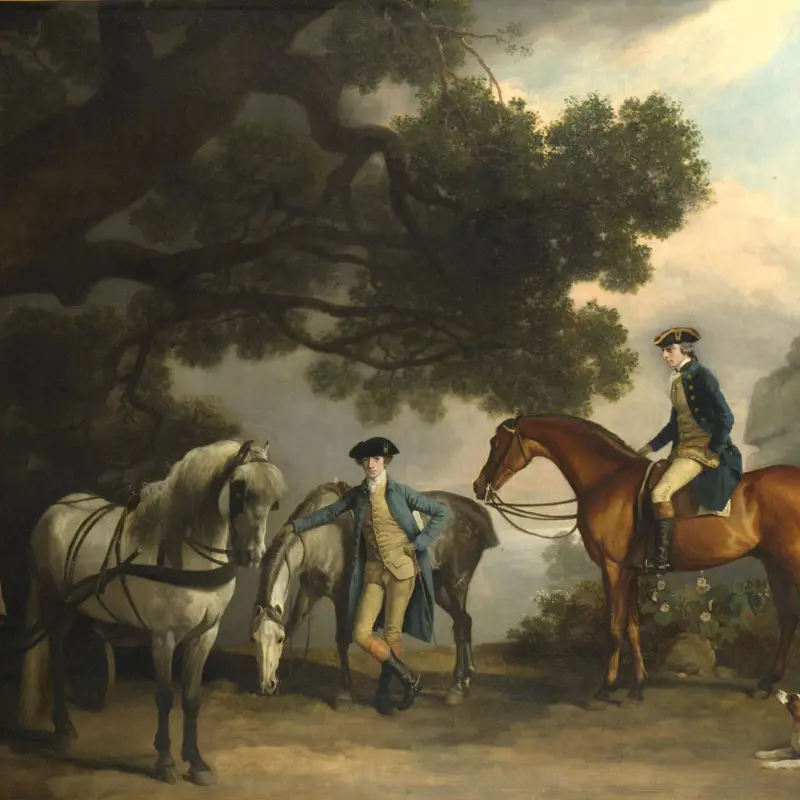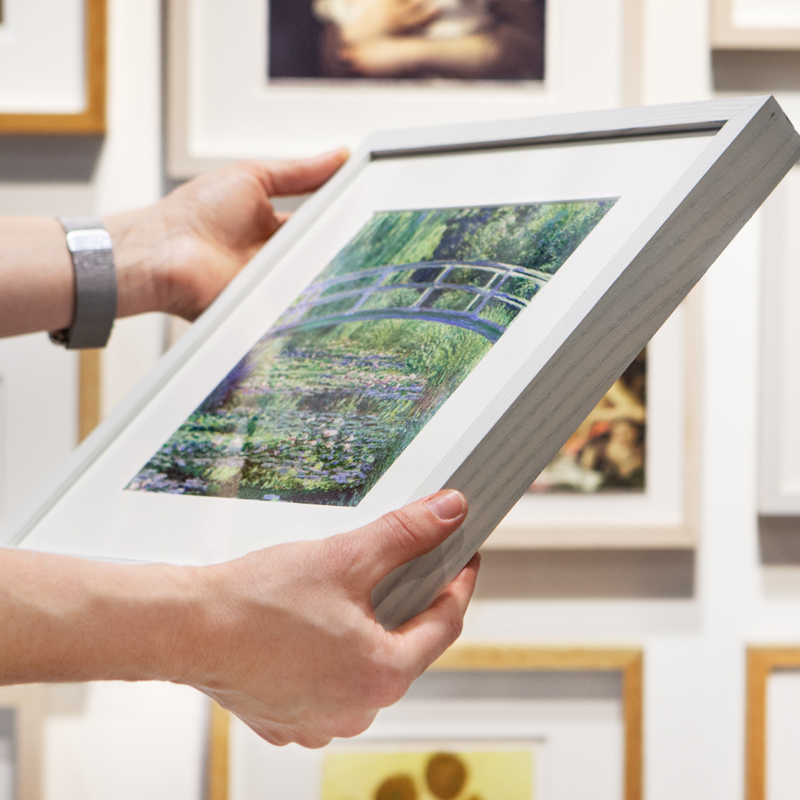George Stubbs, 'Whistlejacket', about 1762
About the work
Overview
One of the most important British paintings of the eighteenth century, Whistlejacket is probably the most well-known portrait of a horse. It is also widely acknowledged to be George Stubbs’s masterpiece. The Arabian chestnut stallion had won a famous victory at York in 1759, but by 1762 had been retired from racing. He belonged to the 2nd Marquess of Rockingham, who commissioned Stubbs to paint a commemorative life-size portrait of his prize horse on a scale that was more appropriate for a group portrait or historical painting.
Stubbs excludes any reference to a rider, riding equipment or location, painting the magnificent rearing horse against a neutral background of pale gold. Despite suggestions that a rider was originally planned, Whistlejacket was always meant to be unmounted. Free from human control, the riderless horse is the embodiment of unrestrained natural energy, a free spirit that prefigures Romanticism’s celebration of nature.
Audio description
Listen to an audio description of George Stubbs's 'Whistlejacket'
Transcript
This is a description of 'Whistlejacket', by the British artist George Stubbs, painted around 1762. It is oil on canvas, nearly 3 metres high by about two and half metres wide, with a thin gilded frame.
This huge painting depicts a life-sized chestnut coloured stallion, rearing up against a neutral buff coloured background. The riderless horse, unfettered by reins or saddle, is presented to us literally as an unbridled free spirit. Painted in profile, his body faces to the right, twisting slightly as he turns his head towards us. Whistlejacket rears up in a levade position, often used in dressage, standing with his weight on his hind legs with his forelegs up off the ground, drawn in towards his body. The strain on his legs is evident in every sinew and muscle which Stubbs precisely depicts.
This is widely acknowledged to be Stubbs’s masterpiece and one of the most famous paintings of a horse ever created, the embodiment of unrestrained natural energy, exuberance, and a perfect specimen of physical health.
A prime example of pure-bred Arabian stock, 'Whistlejacket' exhibits the finest characteristics of the breed. His rich coppery chestnut coat has a shimmering sheen. He received his name from this beautiful colour– a ‘Whistlejacket’ being a mahogany-coloured mixture of treacle and gin used to cure colds.
His tail and mane are a blend of colours from auburn to blond — reputedly the colouring of the original wild horses of Arabia. His tail reaches almost to the floor and is painted in loose, feathery brushstrokes creating a soft effect. We can identify Whistlejacket by his white ‘socks’, markings just above the hooves of his back legs, and the small white patch on his forehead, known as a ‘star’. His head joins his thick neck in a muscular arched curve, tapering down to flaring nostrils on a soft velvety muzzle. He is painted in such a lifelike manner that it is easy to imagine him exhaling warm hay-scented breath. His bulging eyes meet our gaze and the flash of white around the pupils animates them. Alert pricked ears tell us he is aware of our presence and the carefully recorded veins around his eyes and nose make his profile pulsate with life.
In 1762 Stubbs spent several months at Wentworth House, owned by the Marquess of Rockingham, one of the richest men in England. Briefly Prime Minister,
Rockingham’s many passions included collecting classical sculpture, gambling and breeding racehorses. Stubbs completed several paintings of his horses, including Whistlejacket, a previous winner at York.
Stubbs stood out from other equine painters in his thorough understanding of horse anatomy. A few years after painting Whistlejacket, Stubbs spent 18 months dissecting and drawing horse carcasses in a Lincolnshire barn, culminating in the publication of his Anatomy of the Horse in 1766.
The composition of 'Whistlejacket' is likely as much indebted to observations of classical sculpture as to observations of Whistlejacket himself, as a levade could only be held by a horse for a minute or so. The pose, previously used in large heroic equestrian portraits by artists like Rubens and Velázquez, was typically deployed to indicate the majesty or rank of a ruler or military commander in the saddle. Stubbs’ unusual choice to present a riderless horse on a plain background led many writers to speculate that this painting was unfinished. Stories grew that Stubbs planned to add King George III as rider, or employ another artist to paint in a background. We cannot know for sure, but shadows painted under Whistlejacket’s back hooves suggest this is the finished version. The effect creates the feeling of a classical frieze, yet the power of the image lies in Stubb’s ability to both conjure a believable encounter with a living, breathing animal, while at the same time presenting us with an idealised horse for all time.
Key facts
Details
- Full title
- Whistlejacket
- Artist
- George Stubbs
- Artist dates
- 1724 - 1806
- Date made
- About 1762
- Medium and support
- Oil on canvas
- Dimensions
- 296.1 × 248 cm
- Acquisition credit
- Bought with the support of the Heritage Lottery Fund, 1997
- Inventory number
- NG6569
- Location
- Room 34
- Collection
- Main Collection
- Frame
- 18th-century English Frame
Provenance
Additional information
Text extracted from the ‘Provenance’ section of the catalogue entry in Judy Egerton, ‘National Gallery Catalogues: The British Paintings’, London 2000; for further information, see the full catalogue entry.
Exhibition history
-
2018Great Exhibition of the NorthGreat North Museum: Hancock22 June 2018 - 15 September 2018
-
2019George StubbsMK Gallery11 October 2019 - 26 January 2020Mauritshuis20 February 2020 - 1 September 2020
Bibliography
-
1785An Authentic Historical Racing Calendar of All the Plates, Sweepstakes, Matches etc. Run for at York, from … 1709, … to 1785, in Which is also Given Pedigrees and Performances of the Most Celebrated Racehorses, that have Appeared on the English Turf, York 1785
-
1790Liverpool, Liverpool City Libraries, Picton Collection MS 1790: O. Humphry, Particulars of the Life of Mr Stubbs … Given to the Author … by Himself and Committed from His Own Relation, 1790 - 1797
-
1803W. Pick, The Turf Register and Sportsman and Breeder's Stud-Book, York 1803
-
1854G.F. Waagen, Treasures of Art in Great Britain: Being and Account of the Chief Collections of Paintings, Drawings, Sculptures, Illuminated Mss. […], vol. 2, trans. E. Eastlake, London 1854
-
1924H.A. Tipping, 'Wentworth Woodhouse', Country Life, 1924, pp. 438-44
-
1924H.A. Tipping, 'Wentworth Woodhouse', Country Life, 1924, pp. 476-83
-
1924H.A. Tipping, 'Wentworth Woodhouse', Country Life, 1924, pp. 512-9
-
1927P. Toynbee, 'Horace Walpole’s Journals of Visits to Country seats, &c.', The Walpole Society, vol. 16, 1927-28, pp. 9-80
-
1937H. Walpole, Horace Walpole Correspondence, ed. W.S. Lewis, 48 vols, New Haven 1937
-
1953H.F. Constantine, 'Lord Rockingham and Stubbs: Some New Documents', The Burlington Magazine, XCV/604, 1953, pp. 236-8
-
1955C. Hussey, 'Wentworth Woodhouse, Yorkshire', in C. Hussey, English Country Houses: Early Georgian 1715-1760, London 1955
-
1971C.-A. Parker, Mr Stubbs: The Horse Painter, London 1971
-
1972R. Longrigg, The History of Horse Racing, London 1972
-
1973R.J.S. Hoffman, The Marquis: A Study of Lord Rockingham, 1730-82, New York 1973
-
1976J. Egerton, George Stubbs, Anatomist and Animal Painter, London 1976
-
1979J. Egerton, 'The Painter and the Peer: Stubbs and the Patronage of the 1st Lord Grosvenor', Country Life, 1979, pp. 1892-3
-
1984J. Egerton, George Stubbs, London 1984
-
1988S. Deuchar, Sporting Art in Eighteenth-Century England: A Social and Political History, New Haven 1988
-
1990A. Potts, 'Natural Order and the Call of the Wild: The Politics of Animal Picturing', Oxford Art Journal, XIII/1, 1990, pp. 12-33
-
1991N. Penny, 'Lord Rockingham's Sculpture Collection and the Judgment of Paris by Nollekens', J. Paul Getty Museum Journal, XIX, 1991, pp. 5-34
-
1997George Stubbs 1724-1806: Whistlejacket', National Gallery Report, 1998
-
1998National Gallery, The National Gallery Report: April 1997 - March 1998, London 1998
-
1998J. Egerton, The British School, London 1998
-
1998J. Sweetman, The Enlightenment and the Age of Revolution, 1700-1850, London 1998
-
1998C. Plazzotta, 'Acquisition of the Year: Whistlejacket by Stubbs at the National Gallery', Apollo, CXLVIII/442, 1998, pp. 20-1
-
2000Egerton, Judy, National Gallery Catalogues: The British Paintings, revised edn, London 2000
-
2000N.H.J. Hall (ed.), Fearful Symmetry: George Stubbs, Painter of the English Enlightenment (exh. cat. Hall & Knight Ltd, 21 January 2000 - 28 February 2000), New York 2000
-
2000R. Morphet et al., Encounters: New Art from Old (exh. cat. The National Gallery, 14 June - 17 September 2000), London 2000
-
2000N. MacGregor, 'Chef-d'oeuvre: Valeur sûre?', in H. Belting et al., Qu'est-ce qu'un chef-d'oeuvre?, Paris 2000, pp. 67-104
-
2001
C. Baker and T. Henry, The National Gallery: Complete Illustrated Catalogue, London 2001
-
2002J. Egerton, George Stubbs: Le Peintre 'très Anglais' du Cheval, 1724-1806, Paris 2002
-
2003A. Graham-Dixon, In the Picture: The Year through Art, London 2003
-
2004M. Warner and R. Blake, Stubbs and the Horse (exh. cat. Kimbell Art Museum, 14 November 2004 - 6 February 2005; Walters Art Museum, 13 March - 29 May 29 2005; The National Gallery, London, 29 June - 25 September 2005), New Haven 2004
-
2007D. Donald, Picturing Animals in Britain, 1750-1850, New Haven 2007
-
2007J. Egerton, George Stubbs, Painter: Catalogue Raisonné, New Haven 2007
-
2007S. Edwards, 'Poor Ass! a Donkey in Blackpool, 1999', Oxford Art Journal, XXX/1, 2007, pp. 39-54
Frame
The architect William Kent designed one of the most distinctively British styles of frame: an architrave neoclassical frame with projecting corners. The Kent-style frame on Stubbs’s Whistlejacket was made in England in the eighteenth century and is crafted from pinewood. Carved and oil-gilded, the frame has a raised outer moulding with an egg-and-dart motif. The frieze is adorned with Greek fretwork and towards the sight edge there is a ribbon-and-flower motif. Small rosettes embellish the sight corners.
Sometime after 1782, when Whistlejacket was still in the collection at Wentworth House, a ‘Whistlejacket Room’ was created. There, the painting was set in an elaborate Kent frame and integrated into the decorative scheme of white plasterwork.
About this record
If you know more about this work or have spotted an error, please contact us. Please note that exhibition histories are listed from 2009 onwards. Bibliographies may not be complete; more comprehensive information is available in the National Gallery Library.



